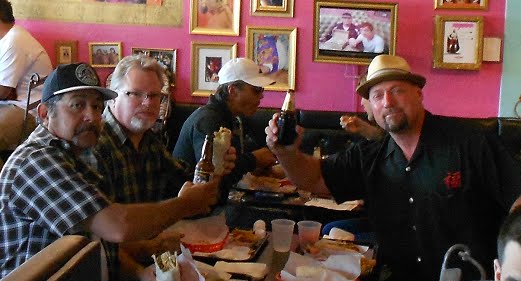Morrison, Colorado is deservedly famous for Red Rocks amphitheater - it is considered the single most attractive and acoustically pleasant place to enjoy a concert. It is the standard by which all other outdoor concert venues are measured.
This has nothing to do with that, This is about the other thing Morrison is world-renown for.
Dinosaur bones.
Layers of Sedimentary rock nearly surround the small town of Morrison. In the late 1800's. dinosaur bones were discovered and subsequently, the infamous "Bone wars" ensued between two highly competitive paleontologists. You can't make this stuff up.
The site of the excavation that yielded the first fossilized bones of Apatosaurus, Dipiodocus, and the Stegosaurus, is known as Quarry no. 10. On view at the small Morrison Natural History Museum are some of the 150-million year old (give or take) bones from the original digs.
The dinosaur above was not found in Morrison - that's me. I'm standing next to a casting of a Tyrannosaurus Rex skull, the original of which was unearthed in South Dakota.
Tyrannosaurus Rex bones were first discovered in Golden, Colorado, about 10 miles from Morrison, back in 1874. Those bones reside in museums on the east coast where they were shipped during the aforementioned "Bone wars," so the MNHM has to settle for castings to represent the fossils that were found in the area.
This bad boy next to the T-Rex is an Allosaurus, which resided in the Morrison area some 150 million years ago, about 20 million years before the T-Rex.
The vertebrae comprising half the neck of an Apatosaurus was part of a discovery made in 1877. No skull was found so artist Maureen Gottron created a representational one until the Museum Foundation can raise the money needed to purchase a research cast skull.
Fossilized plants were also found in the Morrison dig site. This slab of rock reveals a hardwood tree and palm fronds from the Cretaceous period, when Colorado's climate was more like southern Lousiana.
That tiny dinosaur track being pointed to by my host at the Museum, Paleo Tech Doug H., is from an infant Stegosaurus, and it's discovery led to the realization that adults and juvenile Stegosaurus were probably herd animals (as shown in the film Jurassic Park).
The museum has a few modern day relatives of the dinosaurs on display, such as this Dumeril's Monitor Lizard. This particular one was featured on a Discovery Channel documentary on Mosasaurs back in 2009.
This lizard is native to Vietnam and Borneo, and, as a television star, is feed a steady diet of shrimp and an occasional rodent.
The Morrison Natural History Museum also houses a lab where volunteers are slowly working on large boulders found in the area to reveal the fossilized remains hidden in the stone. Here, Kristen, who is a teacher in real-life, uses a small pneumatic chisel on what is thought to be part of a dinosaur skull. It is a tedious process - she told me she had been working on that small area on and off for two months.
The volunteer staff are all skilled Paleo Techs and will readily share their knowledge about the Morrison dig sites and the discoveries made there. They will also allow you to play Paleo Tech yourself if it's a slow enough day. Pretty damn cool, that.
Outside the museum there is a rock garden of sorts that features slabs and boulders of various stone where dinosaur fossils can be found, such as this piece of 300 million year old Arkosic Sandstone.
The rock garden is actually a working lab of sorts, as fossils are being worked out of a number of the big chunks of rock during the day, weather permitting of course.
The Museum is open daily from 10:00 am until 5:00 pm (last admission tickets are sold at 4:00). Admission is $8.00 for adults, and it's worth every penny.













No comments:
Post a Comment